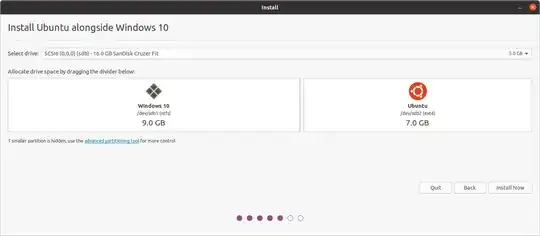Multiboot USB - Windows to Go + Ubuntu Full install + ISO's
Creating a USB drive that will run Windows to Go, Ubuntu Full install and boot Linux and Windows ISO's is a little more complicated than installing Ventoy.
I will outline the process that worked for me:
- Use Rufus to install Windows to Go. This is a very slow process and may take overnight.

- Use a Ubuntu Live pendrive to install Ubuntu alongside Windows on the USB, in the same BIOS/UEFI mode as Windows.

Drop the Linux ISO's of interest into a folder on a ext4 or NTFS partition. (ISO's on a NTFS partition may have trouble shutting down). Windows ISO must go on a XFAT or NTFS partition.
Edit /boot/grub/grub.cfg adding menuentries for the ISO files.
menuentry "ubuntu-20.04.1-desktop-amd64.iso" {
rmmod tpm
set isofile="/ubuntu-20.04.1/ubuntu-20.04.1-desktop-amd64.iso"
loopback loop (hd0,1)$isofile
linux (loop)/casper/vmlinuz boot=casper iso-scan/filename=$isofile noprompt noeject quiet splash maybe-ubiquity persistent persistent-path=/ubuntu-20.04.1/ fsck.mode=skip toram --
initrd (loop)/casper/initrd
}
For booting Windows ISO on MSDOS partition table:
menuentry 'Windows Recovery Environment (on /dev/sda1)' --class windows --class os $menuentry_id_option 'osprober-chain-592C85254E2CD0B7' {
insmod part_msdos
insmod ntfs
set root='hd0,msdos1'
if [ x$feature_platform_search_hint = xy ]; then
search --no-floppy --fs-uuid --set=root --hint-bios=hd0,msdos1 --hint-efi=hd0,msdos1 --hint-baremetal=ahci0,msdos1 592C85254E2CD0B7
else
search --no-floppy --fs-uuid --set=root 592C85254E2CD0B7
fi
parttool ${root} hidden-
drivemap -s (hd0) ${root}
chainloader +1
ntldr /bootmgr
}
For booting Windows ISO on GPT partition table substitute:
insmod part_gpt
insmod ntfs
set root='hd0,gpt1'
- Add persistence folders and files for the ISO's if required.
Reference:
How to Create a Full Install of Ubuntu 20.04 to USB Device Step by Step
BIOS/UEFI Template Image for Booting ISO Files
Installing Windows 10 without USB with ubuntu 18.04: this is not a bootable disk error

